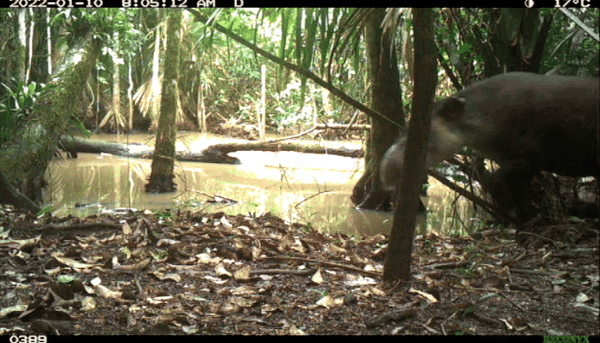There are four species of tapir in the world and Central America is home to the Tapirus bairdii species, considered a symbol of the jungle and fertility, present in myths and legends of various indigenous communities.
This April 27th, we celebrate their presence in the Great Forests of Mesoamerica, as they play a crucial role in seed dispersal, thus contributing to the regeneration of tropical forests where they inhabit. Their distribution spans southern Mexico, Guatemala, Belize, Honduras, Costa Rica, Nicaragua, Panama, northwestern Colombia (Chocó and Darién) and historically in El Salvador. (Source: IUCN)

Tapir captured in the Mayan Biosphere Reserve by the biological research department of WCS Guatemala.
Threats
Despite its importance, the tapir faces various threats, including habitat loss due to deforestation and forest fragmentation, as well as poaching. Recent data of the International Union for Conservation of Nature (IUCN) reveal that three of the four tapir species are classified as "vulnerable" or "endangered." The Central American tapir (Tapirus bairdii) is listed as "endangered", while the Amazonian tapir (Tapirus terrestris) and the malaysian tapir (Tapirus indicus) are classified as "vulnerable".
It is essential to take concrete measures to protect this species. This includes actions such as the conservation and restoration of their natural habitat, as well as the creation of biological corridors that facilitate their movement and promote connectivity between different populations. These initiatives not only benefit the species in question, but also contribute to the maintenance of biodiversity and ecological balance in the ecosystem in general.
Here are 7 fascinating facts about the tapir:
- Impressive size and weight: Central American tapirs are the largest terrestrial mammals in Central America, weighing up to 300 kg and measuring around 2 meters in length.
- Prolonged gestation: Females have a long gestation period that lasts around 13 months.
- Prehensile noses: They have a characteristic long and flexible nose which allows them to manipulate leaves and fruits.
- Aquatic habitat: Unlike other tapirs, the Central American tapir is an excellent swimmer and often immerses in rivers and lagoons to find food and cool off. They are semi-aquatic creatures and can stay underwater for extended periods.
- Solitary behavior: They are generally solitary and nocturnal animals, although they can sometimes be seen in small family groups. They prefer the tranquility of dense forests and are usually shy and elusive in the presence of humans.
- Peculiar coloration: Their fur is dark brown or black, with some variations in tones and patterns among individuals. Some have white or gray spots on the face and throat, which can help camouflage in their environment.
- Key species: They are considered a key species in tropical ecosystems, as they play a crucial role in seed dispersal and forest regeneration by consuming fruits and depositing seeds in different places through their feces.
On this International Tapir Day, let’s remember our shared responsibility to protect this unique species.
Happy International Tapir Day!
We Stand for Wildlife